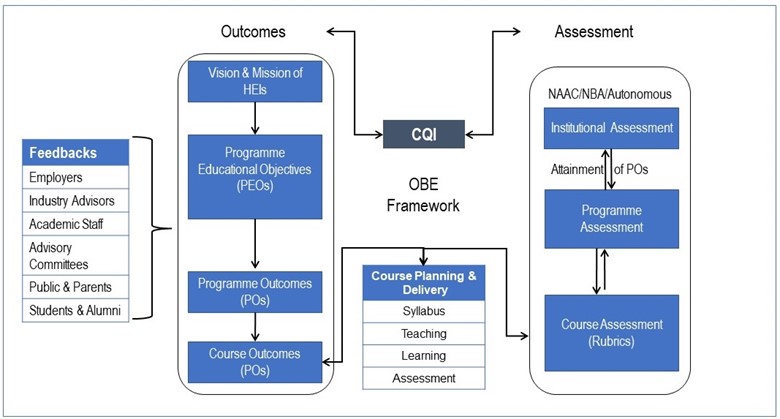OBE Framework
Outcome Based Education (OBE): It is a method (or approach) of curriculum design and teaching that focuses on what students can actually do after they are taught. The desired outcomes are determined first and the programme curriculum, teaching and learning methodology and supporting facilities are designed to support the intended outcomes.

Implementation of OBE
The academy will provide the implementation of Outcome-Based Education (OBE) which is a student-centric learning model that helps teachers to plan the course delivery and assessment. It is implemented as per the following steps:
- Define Vision statements, Mission statements for the Institute and department!
- Define Program Educational Objectives
- GA, PO & PSO Statements
- Define Course Objectives
- Map courses with Program outcomes at suitable levels of Bloom’s Taxonomy
- Define Course Outcomes with Bloom’s Taxonomy for each course.
- Map topics with Course outcomes
- Prepare lecture-wise Course Lesson Plan
- Define pedagogical tools for course outcomes delivery.
- Define rubrics for Tutorial, Practical, seminar, Mini Project, Final year Projec
- Use Learning Management Tool such as Moodle for Assignments, Quizzes, Content beyond syllabus coverage, Tests, course feedback etc.
- Measure the attainment of each CO through Direct/Indirect assessments.
- Track students’ performance
- Identify Gaps in the Curriculum and adopt suitable measures to bridge the Gap.
- Compare PO/PSO for last 3 academic years and propose remedial actions.
- Assess the attainment of Program Educational Objectives
Graduate Attributes (GAs):
- The GAs are exemplars of the qualities and attributes expected of a graduate from an accredited programme.
- Graduates Attributes (GAs) are the components indicative of the graduate’s potential to acquire competence to practice at the appropriate level.
Program Outcomes (POs):
- Program outcomes are statements that describe what students are expected to know and be able to do upon graduating from the program.
- These relate to the skills, knowledge, analytical ability, attitude, and behavior that students acquire through the program at the end of 3/4 years.
- The POs essentially indicate what the students can do from the knowledge acquired by them during the program.
- As such, POs define the professional profile of an engineering graduate. NBA has defined the following 12 POs for an engineering graduate and are applicable to all engineering programs:
Program Specific Outcomes (PSOs)
- Program Specific Outcomes are statements that describe what the graduates of a specific engineering program should be able to do.
- PSOs characterize the specificity of the core courses of a program.
- The POs are important as a guideline when developing or revising the course outcomes.
- PSOs are defined based on the Centre of Excellence of the Department.
- Generally, 2 to 4 Program Specific Outcomes (PSOs) that the graduates of the program will attain should be defined for each department.
Course Outcomes (COs):
- It is a detailed description of what a student must be able to do at the end of a course.
- COs are the statements of Knowledge/ Skills/ Attitude that students are expected to know, understand, and perform, as a result of learning experiences.
- Course Outcome remains the base of the hierarchy of outcomes and is the tools that can be used to measure student performance in each course.
- The course outcomes need to be concise descriptions of what learning is expected to take place by course completion.
- It should be narrower and measurable statements.
- Well-written COs facilitate the faculty in measuring the achievement of the CO at the end of the semester. It also helps the faculty in designing suitable delivery and assessment methods to achieve the designed COs.
- New COs are developed when a new course is offered.
Mapping (CO/PO/PEO)
- The Course Outcomes should be mapped with at least one of the PO i.e. all POs can be adequately addressed through the selection of core courses and their COs
- When designing the COs, faculty handling the course should map their COs to the appropriate PO in order to ensure that all POs are delivered throughout the period of study.
- Write the COs for a course and see to what extent each of those CO’s correlate with the POs.
Computation of CO attainment
Course outcomes will be attained through direct and indirect methods.
Direct Attainment:
The following criteria are considered in the direct attainment.
- Conduction of Two Mid Semester Examination based on COs
- Class performance activities
- Assignments
- Tutorials
- Skill based Mini Projects
- Quizzes
- Case studies related to COs.
- End Term Examinations
Indirect Attainment:
- Feedback from student on the framed questionnaires
